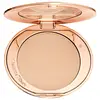Charlotte Tilbury Airbrush Flawless Finish Setting Powder Versus Sunnies Face Skin So Good The Multistick
What's inside
What's inside
 Key Ingredients
Key Ingredients

 Benefits
Benefits

 Concerns
Concerns

 Ingredients Side-by-side
Ingredients Side-by-side

Talc
AbrasiveMica
Cosmetic ColorantPolymethyl Methacrylate
Dimethicone
EmollientSilica
AbrasivePentaerythrityl Tetraisostearate
EmollientCetearyl Ethylhexanoate
EmollientZinc Stearate
Cosmetic ColorantZea Mays Starch
AbsorbentChlorphenesin
AntimicrobialPotassium Sorbate
PreservativeTocopheryl Acetate
AntioxidantPei-10
Propylene Glycol
HumectantPrunus Amygdalus Dulcis Oil
Skin ConditioningRosa Multiflora Flower Wax
Skin ConditioningTetrasodium EDTA
Water
Skin ConditioningDimethiconol
EmollientTilia Cordata Flower Extract
Skin ConditioningMethylparaben
PreservativeEthylparaben
PreservativePropylparaben
PreservativeButylparaben
MaskingCI 77891
Cosmetic ColorantIron Oxides
Talc, Mica, Polymethyl Methacrylate, Dimethicone, Silica, Pentaerythrityl Tetraisostearate, Cetearyl Ethylhexanoate, Zinc Stearate, Zea Mays Starch, Chlorphenesin, Potassium Sorbate, Tocopheryl Acetate, Pei-10, Propylene Glycol, Prunus Amygdalus Dulcis Oil, Rosa Multiflora Flower Wax, Tetrasodium EDTA, Water, Dimethiconol, Tilia Cordata Flower Extract, Methylparaben, Ethylparaben, Propylparaben, Butylparaben, CI 77891, Iron Oxides
CI 77891
Cosmetic ColorantCaprylic/Capric Triglyceride
MaskingIsodecyl Neopentanoate
EmollientIsononyl Isononanoate
EmollientMicrocrystalline Wax
Emulsion StabilisingSqualene
EmollientDicalcium Phosphate
AbrasivePolyethylene
AbrasiveVp/Hexadecene Copolymer
Synthetic Wax
AbrasiveDisteardimonium Hectorite
StabilisingHydrogenated Polyisobutene
EmollientCI 77492
Cosmetic ColorantSilica
AbrasiveMica
Cosmetic ColorantNylon-12
Iron Oxides
CI 77491
Cosmetic ColorantWater
Skin ConditioningAlcohol
AntimicrobialPentaerythrityl Tetra-Di-T-Butyl Hydroxyhydrocinnamate
AntioxidantCI 42090
Cosmetic ColorantButyl Stearate
EmollientIsostearyl Alcohol
EmollientButylene/Ethylene/Styrene Copolymer
Ethylene/Propylene/Styrene Copolymer
Dibutyl Lauroyl Glutamide
Skin ConditioningTocopheryl Acetate
AntioxidantGlycerin
HumectantOpuntia Tuna Fruit Extract
Skin ConditioningRubus Idaeus Leaf Extract
Skin ConditioningVitis Vinifera Fruit Extract
Skin ConditioningCI 77891, Caprylic/Capric Triglyceride, Isodecyl Neopentanoate, Isononyl Isononanoate, Microcrystalline Wax, Squalene, Dicalcium Phosphate, Polyethylene, Vp/Hexadecene Copolymer, Synthetic Wax, Disteardimonium Hectorite, Hydrogenated Polyisobutene, CI 77492, Silica, Mica, Nylon-12, Iron Oxides, CI 77491, Water, Alcohol, Pentaerythrityl Tetra-Di-T-Butyl Hydroxyhydrocinnamate, CI 42090, Butyl Stearate, Isostearyl Alcohol, Butylene/Ethylene/Styrene Copolymer, Ethylene/Propylene/Styrene Copolymer, Dibutyl Lauroyl Glutamide, Tocopheryl Acetate, Glycerin, Opuntia Tuna Fruit Extract, Rubus Idaeus Leaf Extract, Vitis Vinifera Fruit Extract
 Reviews
Reviews

Ingredients Explained
These ingredients are found in both products.
Ingredients higher up in an ingredient list are typically present in a larger amount.
Ci 77891 is a white pigment from Titanium dioxide. It is naturally found in minerals such as rutile and ilmenite.
It's main function is to add a white color to cosmetics. It can also be mixed with other colors to create different shades.
Ci 77891 is commonly found in sunscreens due to its ability to block UV rays.
Learn more about CI 77891Mica is a naturally occurring mineral used to add shimmer and color in cosmetics. It can also help improve the texture of a product or give it an opaque, white/silver color.
Serecite is the name for very fine but ragged grains of mica.
This ingredient is often coated with metal oxides like titanium dioxide. Trace amounts of heavy metals may be found in mica, but these metals are not harmful in our personal products.
Mica has been used since prehistoric times throughout the world. Ancient Egyptian, Indian, Greek, Roman, Aztec, and Chinese civilizations have used mica.
Learn more about MicaSilica, also known as silicon dioxide, is a naturally occurring mineral. It is used as a fine, spherical, and porous powder in cosmetics.
Though it has exfoliant properties, the function of silica varies depending on the product.
The unique structure of silica enhances the spreadability and adds smoothness, making it a great texture enhancer.
It is also used as an active carrier, emulsifier, and mattifier due to its ability to absorb excess oil.
In some products, tiny microneedles called spicules are made from silica or hydrolyzed sponge. When you rub them in, they lightly polish away dead skin layers and enhance the penetration of active ingredients.
Learn more about SilicaTocopheryl Acetate is AKA Vitamin E. It is an antioxidant and protects your skin from free radicals. Free radicals damage the skin by breaking down collagen.
One study found using Tocopheryl Acetate with Vitamin C decreased the number of sunburned cells.
Tocopheryl Acetate is commonly found in both skincare and dietary supplements.
Learn more about Tocopheryl AcetateWater. It's the most common cosmetic ingredient of all. You'll usually see it at the top of ingredient lists, meaning that it makes up the largest part of the product.
So why is it so popular? Water most often acts as a solvent - this means that it helps dissolve other ingredients into the formulation.
You'll also recognize water as that liquid we all need to stay alive. If you see this, drink a glass of water. Stay hydrated!
Learn more about WaterThis ingredient is a combination of red, black, and yellow iron oxide pigments. This combination of colors is usually found in foundation, because it results in a "skin" color.